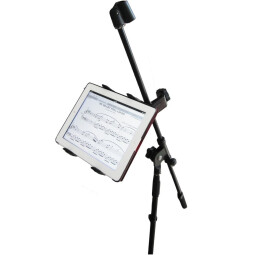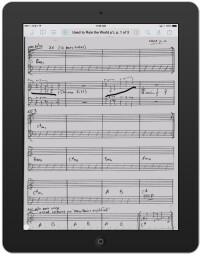If you’re one of those performing musicians who needs to bring charts and lyric sheets to the gig or rehearsal, you might want to consider getting rid of all that paper and your music stand, and conveniently viewing and storing all of those documents on an iPad or other tablet. Let’s look at the pros and cons.
This story focuses on iPads, but it’s also possible to create an onstage chart/lyric sheet/set-list reading setup for an Android tablet, although you’ll have less options in terms of apps and accessories.
Take one tablet at show time
So what are the advantages of using an iPad rather than paper onstage? Convenience is the biggest factor. Once you’ve loaded a chart, lyric sheet or setlist into your iPad — by importing a scanned PDF of it into a sheet music reader app — it’s there permanently (don’t forget to back up to your computer, of course). That means you don’t need to remember to bring the right music with you to the gig or rehearsal.
|
As you can see from this iPad stand mount from Charger City, you can get your iPad very close to your face by attaching it to the arm of a boom stand.
|
You could have hundreds of songs and sets loaded, and always at your fingertips. If you play in multiple bands, you could create a separate folder for each, if you want. You can also keep setlists in your iPad, and save all of them as well. There are dedicated setlist apps available, but you can also just store them as PDFs in your score reader app.
Let there be light
Unless you’re standing with direct sunlight on your screen, an iPad is very easy to read in multiple lighting conditions. Even on a very dark stage, you won’t need a dedicated light like you do with paper charts on a music stand.
With the proper accessory, you can even turn pages hands free on your iPad. It will require that you invest a bit more, and buy a Bluetooth foot pedal (typically around $150), but if page turns are a hassle for you, this type of setup could be just what you were looking for. A press with your foot on the pedal lets you turn the page without having touch your screen, leaving your hands free to play your instrument.
By going the iPad route, you’ll also be more visible onstage. No more bulky music stand blocking part of the view of you from the audience.
But that’s not all. You can also use your iPad for other onstage tasks, thanks to the range of useful music utility apps such as tuners, metronomes, and sound-pressure-level (SPL) meters. A number of score reader apps, such as the very fully featured forScore (which I use and really like) have many of these features built in. And of course, having your iPad with you means you can play games or read or watch videos on your breaks.
Cough up the dough
There are some downsides to using an iPad instead of paper, the main one being financial. iPad not withstanding, you’ll need to invest in a stand mount, and possibly a page-turner pedal. If you don’t already have an iPad, or aren’t planning to get one anyway, you’re looking at an investment of close to $1,000 for the iPad, stand mount, pedal and the app. But if you do have one, you’'ll only need to spend about $50 without a Bluetooth pedal and $200 with, which might make sense for you.
Another potential drawback is that the iPad’s screen is not as large as a typical sheet of music paper, and if you turn it to landscape mode to view two pages at a time, it’s even smaller. The size issue is mitigated somewhat by the fact that you can get the iPad closer to your face on a stand mount than the music would be on a music stand.
Then there’s the issue of security. An iPad is valuable and small enough to be easily swiped when you’re not looking, and you might not want to leave it onstage during your breaks (even attached to a mount). If you’re concerned about theft, you can take it with you on breaks (making it possible to play those games or watch videos in between sets) or get a security cable of some type. While there’s no security cable port on an iPad, there are options for securing it (for instance this one from MacLocks) and there are even iPad cases with security cables attached.
You’ll also have to either plug-in your iPad during the gigs, or make sure to charge it religiously in advance, so that you don’t run out of juice in the middle of a set.
Primal screen
Even with the aforementioned caveats, there’s no doubt that it’s very convenient and also just kind of cool use an iPad instead of carting around folders full of papers, a music stand, and a stand light; and it can make your gig and rehearsal life a lot easier in a number of ways. I just took the plunge myself, and am glad I did.
For more info about stand mounts, score reader apps and page turners, see the appropriate sections in the Audiofanzine story, iOS Onstage.


